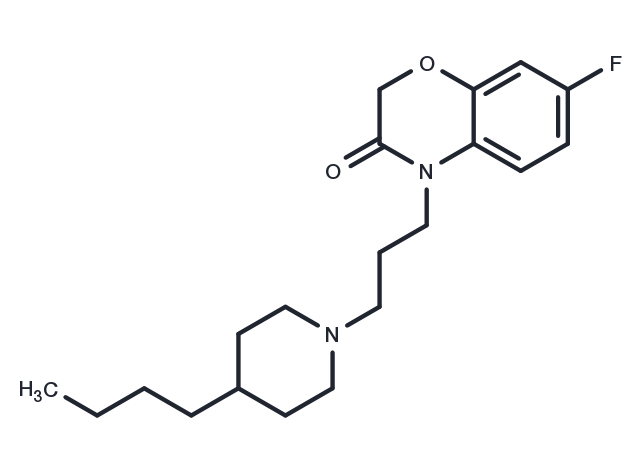Powder: -20°C for 3 years | In solvent: -80°C for 1 year


AC260584 is an M1 muscarinic receptor allosteric agonist (pEC50: 7.6).

| Pack Size | Availability | Price/USD | Quantity |
|---|---|---|---|
| 5 mg | 6-8 weeks | $ 327.00 | |
| 25 mg | 6-8 weeks | $ 1,140.00 | |
| 50 mg | 6-8 weeks | $ 1,490.00 | |
| 100 mg | 6-8 weeks | $ 1,990.00 | |
| 1 mL * 10 mM (in DMSO) | 6-8 weeks | $ 270.00 |
| Description | AC260584 is an M1 muscarinic receptor allosteric agonist (pEC50: 7.6). |
| Targets&IC50 | M1:(pEC50)7.6 |
| In vitro | AC260584 is identified as a potent (pEC50=7.6-7.7) and efficacious (90-98% of carbachol) agonist for the muscarinic M1 receptor, exhibiting significant functional selectivity over the M2, M3, M4, and M5 subtypes of muscarinic receptors. This selectivity profile of AC260584 is consistent across native tissues expressing mAChRs and recombinant systems. |
| In vivo | In rodent studies, AC260584 has been shown to activate the phosphorylation of extracellular signal-regulated kinase 1 and 2 (ERK1/2) in the hippocampus, prefrontal cortex, and perirhinal cortex. This activation is contingent upon the activation of muscarinic M1 receptors, as evidenced by its absence in M1 receptor knockout mice. Furthermore, AC260584 enhances cognitive performance in mice, as demonstrated in the novel object recognition test, with this effect being inhibited by the muscarinic receptor antagonist pirenzepine. Additionally, AC260584 has been noted for its oral bioavailability in rodents. At doses of 3 and 10 mg/kg, AC260584 significantly boosts dopamine release in the medial prefrontal cortex and hippocampus, while only the 10 mg/kg dose notably increases acetylcholine release in these areas. |
| Molecular Weight | 348.45 |
| Formula | C20H29FN2O2 |
| CAS No. | 560083-42-3 |
Powder: -20°C for 3 years | In solvent: -80°C for 1 year
DMSO: 50 mg/mL (143.49 mM)
You can also refer to dose conversion for different animals. More
bottom
Please see Inhibitor Handling Instructions for more frequently ask questions. Topics include: how to prepare stock solutions, how to store products, and cautions on cell-based assays & animal experiments, etc.
AC260584 560083-42-3 Others AC 260584 AC-260584 inhibitor inhibit
